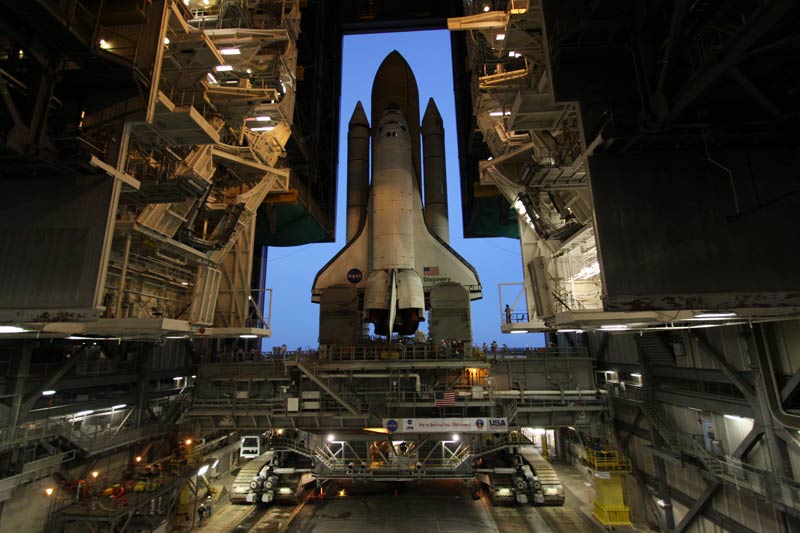NASA's Extra Shuttle Flight Hangs In The Balance

WASHINGTON? Less than two weeks before the space shuttle Discovery is scheduled to launchon its last flight, uncertainty still remains as to exactly when NASA's very finalorbiter mission will fly, bringing the storied shuttle era to a close nextyear.
NASAhas two scheduled shuttle missions, on Discovery and Endeavour, left to flybefore retiring its orbiter fleet in 2011. A third, extrashuttle mission has been approved by Congress and President Obama, but stillfaces review by congressional appropriators later this year.
ButNASA's shuttle program manager John Shannon told reporters Thursday (Oct. 21) thatdefinitive plans have not yet been made as to whether the potential third andfinal shuttle mission will fly to the International Space Station. [Gallery:Shuttle Discovery's Last Launch Pad Trip]
"Itold my team it was 50/50," Shannon said.
Discoveryis poised to launch Nov. 1 on an 11-day mission to deliver a storage room andhumanoid robot to the International Space Station. The mission will be the 39thand lastspace voyage for Discovery ? NASA's oldest flying shuttle.
Theshuttle Endeavour is set to follow Discovery's final flight with one lastmission of its own in early 2011.
NASA'sthird shuttle in service, Atlantis, is being prepared to serve as a possiblerescue vehicle for Endeavour's flight ? scheduled to launch Feb. 27. Havingbackup shuttles ready has been standard for NASA since the tragic 2003 loss ofshuttle Columbia and its crew.
Get the Space.com Newsletter
Breaking space news, the latest updates on rocket launches, skywatching events and more!
Thefleet is being retired to make way for new missions to an asteroid by 2025 andMars in the 2030s. NASA will rely on Russian, European and Japanese spacecraftto ferry crews and supplies to the space station until U.S. commercialspacecraft become available.
Onelast flight
NASAwould prefer to shift Atlantis out of standby status and use it for one lastcargo mission to the InternationalSpace Station.
Todo that, the agency needs approval from congressional appropriators in order toset aside the funding required for the extra mission. NASA's space shuttleprogram costs about $200 million a month to operate, agency officials havesaid.
Presently,the final shuttle mission ? called STS-135 ? would most likely see Atlantislaunch on a summer flight no earlier than June 2011.
"There?sgoing to be a lot of discussions between now and the summer if we?re going tofly 135 exactly where we?re going to fly it," Shannon said. "Does it make senseto delay a bit and get the ISS in better shape?"
Thepotential third and final shuttle flight will be critical in maintaining thespace station, officials said.
"Ihave to point out how important that flight is to the International SpaceStation," Shannon explained. "From a logistics standpoint, I think 2012 isgoing to be a real challenge."
Forone, after the shuttlesare retired, NASA will lack the ability to ferry large payloads to thestation.
Russia'sunmanned Progress spacecraft routinely hauls about 2.5 tons of cargo to thestation per flight. European and Japanese robotic freighters can larger loads,but not as much as the shuttle.
"Myoperations guy said one shuttle flight is equivalent to roughly seven Progressflights," Shannon said. "So, getting to fly 135 late is going to give the spacestation margin to keep six crew (members) up, to keep doing research."
Spacesupply shortage risks
NASAofficials also said that if scheduled demonstration of commercial supply shipsare delayed between the launch of Endeavour's STS-134 flight in February andthe proposed summer STS-135 flight, the space station could face a dangerousshortage of essential provisions.
Accordingto projections, that challenge would likely come at the tail end of 2011,moving into 2012, said Dan Hartman, Integration and Mission Operations managerfor the International Space Station Program.
Yet,the final decision will likely be driven primarily by budgetary constraints.
"Asfar as how far could we push back the June flight? It all depends on money," Shannon said. "We?ll work with headquarters on the money, then that will define how far outwe can stretch this program."
Still,the agency?s hands remain tied until congressional appropriations are complete.
"Theplan we have put in place allows us to carry through enough money to be able tokeep the program going and make the decision on whether we fly 135 as late as possible,"Shannon said. "But we really can?t make that decision under continuingresolution ? we need appropriation."
- Gallery: Shuttle Discovery's Last Launch Pad Trip
- POLL: What Do You Think About NASA's New Direction?
- Last Crew of Space Shuttle Discovery Practices Launch Escape
Join our Space Forums to keep talking space on the latest missions, night sky and more! And if you have a news tip, correction or comment, let us know at: community@space.com.

Denise Chow is a former Space.com staff writer who then worked as assistant managing editor at Live Science before moving to NBC News as a science reporter, where she focuses on general science and climate change. She spent two years with Space.com, writing about rocket launches and covering NASA's final three space shuttle missions, before joining the Live Science team in 2013. A Canadian transplant, Denise has a bachelor's degree from the University of Toronto, and a master's degree in journalism from New York University. At NBC News, Denise covers general science and climate change.









